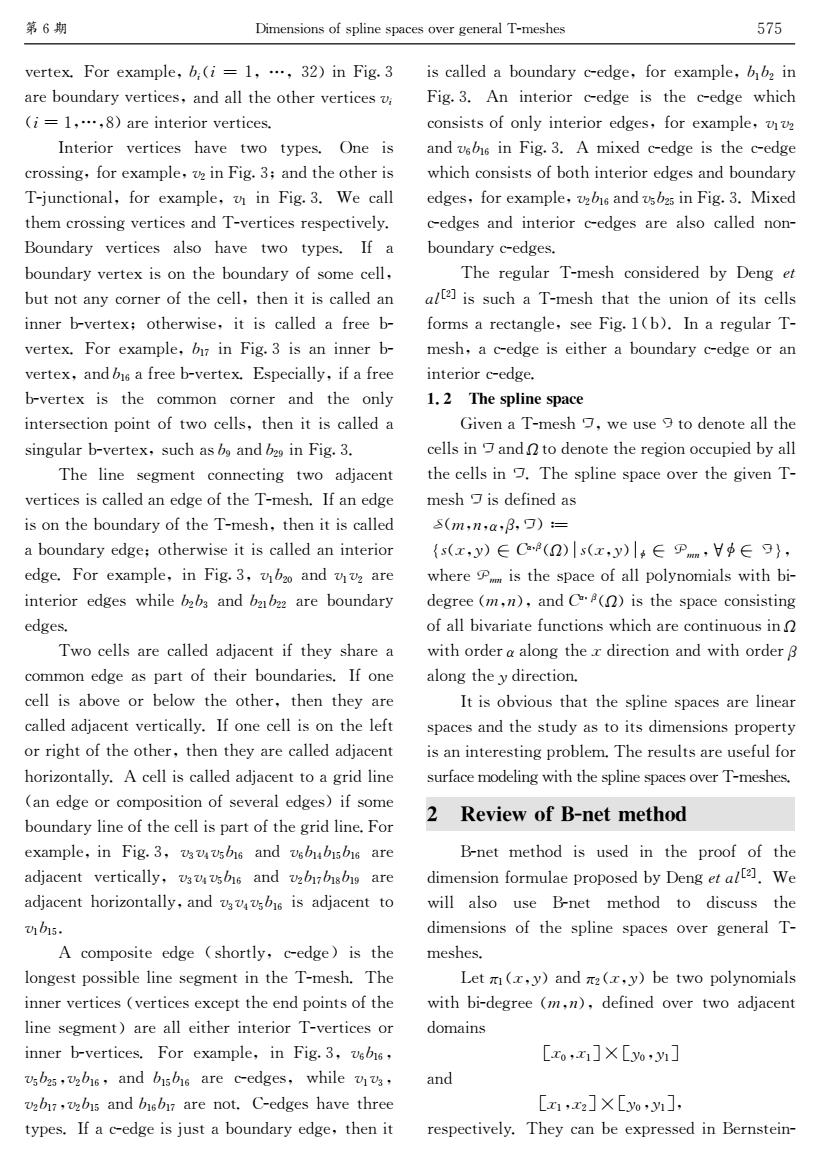正在加载图片...

第B潮 Dimensions of spline spaces over general T-meshes 575 vertex.For example,6,(i 1....32)in Fig.3 is called a houndary c-edge.for example,b in are boundary vertices,and all the other vertices Fig,3.An interior cedge is the eedge which (i =1...8)are interior vertices. consists of only interior edges,for example,vv Interior vertices have two types.One is and nshs in Fig.3.A mixed c-edge is the c-edge crossing.for example,v:in Fig.3:and the other is which consists of both interior cdges and boundary T-junctional,for example,i in Fig.3.We call edges.for example,vzbic and bs in Fig.3.Mixed them crossing vertices and T-vertices respectively. c-edges and interior cedges are also called non- Boundary vertices also have two types.If a boundary eedges. boundary vertex is on the boundary of some cell. The regular T-mesh considered by Deng et but not any corner of the cell,then it is called an alf)is such a T-mesh that the union of its cells inner b-vertex:otherwise,it is called a free b- forms a reetangle,see Fig.1(b).In a regular T- vertex.For example,by in Fig.3 is an inner b mesh,a cedge is either a boundary cedge or an vertex.and bie a free b-vertex.Especially.if a free interior c-edge. vertex is the common corner and the only 1.2 The spline space interxection point of two cells.then it is ralled a Given a T-mesh 7.we use 9 to dennte all the singular h-vertex,such as b and hu in Fig.3. cells in andn to denote the region occupied by all The line segment connecting two adjacent the cells in The spline space over the given T. vertices is called an edge of the T-mesh.If an edge mesh is defined as is on the boundary of the T-mesh.then it is called s(m,a,3,了)= a boundary edge;otherwise it is called an interior {sx,y)∈C)ls(ry)ls∈Pm,V∈9} edge.For example,in Fig.3.and m are where is the space of all polynomials with bi interior edges whileb and babe are boundary degree (m.n).and C(n)is the space consisting edges. of all bivariate functions which are continuous in f Two cells are called adjacent if they share a with order a along the r direction and with order common cdge as part of their boundaries.If one along the y direetion. cell is above or below the other,then they are It is obvious that the spline spaces are lincar called adjacent vertically.If one cell is on the left spaces and the study as to its dimensions property or right of the other,then they are called adjacent is an interesting problem.The results are useful for horizontally.A cell is called adjacent to a grid line surface modeling with the spline spaces over T-meshes (an edge ar composition of several edges)if some 2 boundary line of the cell is part of the grid line.For Review of B-net method example,in Fig.3.vvbv and ibububis are B-net method is used in the proof of the adjacent vertically.and vh6 are dimension formulae proposed by Deng era.We adjacent horizontally,ande is adjacent to will also use B-net method to discuss the 劝. dimensions of the spline spaces over general T. A romposite edge (shortly,c-edge)is the meshes. longest possible line segment in the T-mesh.The Let (c.y)and (r,y)be two polynomials inner vertices (vertices except the end points of the with bi-degree (m,),defined over two adjacent line scgment)are all cither interior T-vertices or domains inner bvertices.For example,in Fig.3,tbie, [西]×[b] hbz,bs,nnd:sare-rges,while的, and and hby are not.C-edges have three [m,]×[h], types.If a e-edge is just a boundary edge,then it respectively.They can be expressed in Bernsteir H2./2Z&\$.2Z?IG%2!:-"-;S!#!!($0,\0@Y! ?.2M$+,J?.UH2./012C!?,J?%%/>2$/>2.H2./012C1- "-;S!#!8$?.20,/2.0$.H2./012C& 3,/2.0$. H2./012C >?H2 /K$ /UG2C& R,20C 1.$CC0,@!O$.2Z?IG%2!1(0,\0@Y!%?,J/>2$/>2.0C F6A+,1/0$,?%!O$.2Z?IG%2!1S0,\0@Y!&L21?%% />2I1.$CC0,@H2./012C?,JF6H2./012C.2CG21/0H2%U& N$+,J?.U H2./012C ?%C$ >?H2 /K$ /UG2C&3O ? M$+,J?.UH2./2Z0C$,/>2M$+,J?.U$OC$I212%%! M+/,$/?,U1$.,2.$O/>212%%!/>2,0/0C1?%%2J?, 0,,2.M6H2./2Z%$/>2.K0C2!0/0C1?%%2J?O.22M6 H2./2Z&\$.2Z?IG%2!:S70,\0@Y!0C?,0,,2.M6 H2./2Z!?,J:S"?O.22M6H2./2Z&BCG210?%%U!0O?O.22 M6H2./2Z0C />2 1$II$, 1$.,2. ?,J />2 $,%U 0,/2.C21/0$,G$0,/$O/K$12%%C!/>2,0/0C1?%%2J? C0,@+%?.M6H2./2Z!C+1>?C:9?,J:(90,\0@Y!& F>2%0,2 C2@I2,/1$,,21/0,@ /K$ ?JA?12,/ H2./012C0C1?%%2J?,2J@2$O/>2F6I2C>&3O?,2J@2 0C$,/>2M$+,J?.U$O/>2F6I2C>!/>2,0/0C1?%%2J ?M$+,J?.U2J@2%$/>2.K0C20/0C1?%%2J?,0,/2.0$. 2J@2&\$.2Z?IG%2!0,\0@Y!!1S:() ?,J1S1( ?.2 0,/2.0$.2J@2CK>0%2:(:! ?,J:(S:(( ?.2M$+,J?.U 2J@2C& FK$12%%C?.21?%%2J?JA?12,/0O/>2UC>?.2? 1$II$,2J@2?CG?./$O/>20.M$+,J?.02C&3O$,2 12%%0C?M$H2$.M2%$K/>2$/>2.!/>2,/>2U?.2 1?%%2J?JA?12,/H2./01?%%U&3O$,212%%0C$,/>2%2O/ $..0@>/$O/>2$/>2.!/>2,/>2U?.21?%%2J?JA?12,/ >$.0Q$,/?%%U&-12%%0C1?%%2J?JA?12,//$?@.0J%0,2 "?,2J@2$.1$IG$C0/0$,$OC2H2.?%2J@2C$0OC$I2 M$+,J?.U%0,2$O/>212%%0CG?./$O/>2@.0J%0,2&\$. 2Z?IG%2!0, \0@Y!!1!1T15:S" ?,J1":ST:S5:S" ?.2 ?JA?12,/H2./01?%%U!1!1T15:S" ?,J1(:S7:S8:S9 ?.2 ?JA?12,/>$.0Q$,/?%%U!?,J1!1T15:S"0C?JA?12,//$ 1S:S5< - 1$IG$C0/22J@2 "C>$./%U!162J@2$0C/>2 %$,@2C/G$CC0M%2%0,2C2@I2,/0,/>2F6I2C>&F>2 0,,2.H2./012C"H2./012C2Z12G//>22,JG$0,/C$O/>2 %0,2C2@I2,/$?.2?%%20/>2.0,/2.0$.F6H2./012C$. 0,,2.M6H2./012C&\$.2Z?IG%2!0, \0@Y!!1":S"! 15:(5!1(:S"!?,J:S5:S" ?.2162J@2C!K>0%21S1!! 1(:S7!1(:S5 ?,J:S":S7 ?.2,$/&V62J@2C>?H2/>.22 /UG2C&3O?162J@20CA+C/?M$+,J?.U2J@2!/>2,0/ 0C1?%%2J?M$+,J?.U162J@2!O$.2Z?IG%2!:S:(0, \0@Y!&-,0,/2.0$.162J@20C/>2162J@2 K>01> 1$,C0C/C$O$,%U0,/2.0$.2J@2C!O$.2Z?IG%2!1S1( ?,J1":S"0,\0@Y!&- I0Z2J162J@20C/>2162J@2 K>01>1$,C0C/C$OM$/>0,/2.0$.2J@2C?,JM$+,J?.U 2J@2C!O$.2Z?IG%2!1(:S"?,J15:(50,\0@Y!&‘0Z2J 162J@2C?,J0,/2.0$.162J@2C?.2?%C$1?%%2J,$,6 M$+,J?.U162J@2C& F>2.2@+%?. F6I2C>1$,C0J2.2JMU 42,@"& $6&(’ 0CC+1>?F6I2C>/>?//>2+,0$,$O0/C12%%C O$.IC?.21/?,@%2!C22\0@YS"M$&3,?.2@+%?.F6 I2C>!?162J@20C20/>2.?M$+,J?.U162J@2$.?, 0,/2.0$.162J@2& FG@ 02$&)*"%$&)+,$ <0H2,?F6I2C>!!K2+C2"/$J2,$/2?%%/>2 12%%C0,!?,J!/$J2,$/2/>2.2@0$,$11+G02JMU?%% />212%%C0,!<F>2CG%0,2CG?12$H2./>2@0H2,F6 I2C>!0CJ2O0,2J?C #"’!(!"!#!!$=; (/">!2$#8"!#"!$/">!2$$ # $’(!$$# ")! K>2.2$’(0C/>2CG?12$O?%%G$%U,$I0?%CK0/>M06 J2@.22"’!($!?,J8"!#"!$0C/>2CG?121$,C0C/0,@ $O?%%M0H?.0?/2O+,1/0$,CK>01>?.21$,/0,+$+C0,! K0/>$.J2."?%$,@/>2>J0.21/0$,?,JK0/>$.J2.# ?%$,@/>22J0.21/0$,& 3/0C$MH0$+C/>?//>2CG%0,2CG?12C?.2%0,2?. CG?12C?,J/>2C/+JU?C/$0/CJ0I2,C0$,CG.$G2./U 0C?,0,/2.2C/0,@G.$M%2I&F>2.2C+%/C?.2+C2O+%O$. C+.O?12I$J2%0,@K0/>/>2CG%0,2CG?12C$H2.F6I2C>2C& @ C$-"$8’(E1%$5#$52’9 N6,2/ I2/>$J0C +C2J0,/>2 G.$$O$O/>2 J0I2,C0$,O$.I+%?2G.$G$C2JMU42,@"&$6&(’ &L2 K0%% ?%C$ +C2 N6,2/ I2/>$J /$ J0C1+CC />2 J0I2,C0$,C$O/>2CG%0,2CG?12C$H2.@2,2.?%F6 I2C>2C& D2/%S">!2$?,J%(">!2$M2/K$G$%U,$I0?%C K0/>M06J2@.22"’!($!J2O0,2J$H2./K$?JA?12,/ J$I?0,C &>)!>S’?&2)!2S’ ?,J &>S!>(’?&2)!2S’! .2CG21/0H2%U&F>2U1?,M22ZG.2CC2J0,N2.,C/20,6 K"2 40I2,C0$,C$OCG%0,2CG?12C$H2.@2,2.?%F6I2C>2C 575